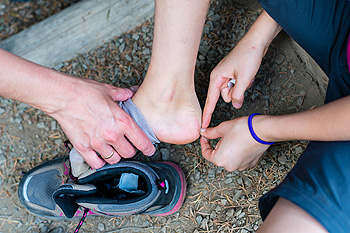Blisters and Shoes
Monday, 04 May 2020 00:00 People who enjoy hiking are often aware that blisters may develop on their feet. They form as a result of excess friction between the sock and the shoe, which may cause difficulty walking. A blister is defined as a small area that is filled with fluid and forms over the damaged skin. Its purpose is to protect the new skin as it develops, and will gradually drain when it is no longer needed. Many blisters may be prevented by wearing shoes and socks that fit properly, and recognizing the first signs a blister may be forming. Treating a blister can be done by applying an antibiotic ointment on and around the affected area, in addition to wearing a protective covering over it. For additional information about why blisters form on the feet and how to treat them, please consult with a podiatrist.
People who enjoy hiking are often aware that blisters may develop on their feet. They form as a result of excess friction between the sock and the shoe, which may cause difficulty walking. A blister is defined as a small area that is filled with fluid and forms over the damaged skin. Its purpose is to protect the new skin as it develops, and will gradually drain when it is no longer needed. Many blisters may be prevented by wearing shoes and socks that fit properly, and recognizing the first signs a blister may be forming. Treating a blister can be done by applying an antibiotic ointment on and around the affected area, in addition to wearing a protective covering over it. For additional information about why blisters form on the feet and how to treat them, please consult with a podiatrist.
Blisters are prone to making everyday activities extremely uncomfortable. If your feet are hurting, contact one of our podiatrists of Family Foot Care. Our doctors can provide the care you need to keep you pain-free and on your feet.
Foot Blisters
Foot blisters develop as a result of constantly wearing tight or ill-fitting footwear. This happens due to the constant rubbing from the shoe, which can often lead to pain.
What Are Foot Blisters?
A foot blister is a small fluid-filled pocket that forms on the upper-most layer of the skin. Blisters are filled with clear fluid and can lead to blood drainage or pus if the area becomes infected.
How Do Blisters Form?
Blisters on the feet are often the result of constant friction of skin and material, usually by shoe rubbing. Walking in sandals, boots, or shoes that don’t fit properly for long periods of time can result in a blister. Having consistent foot moisture and humidity can easily lead to blister formation.
Prevention & Treatment
It is important to properly care for the affected area in order to prevent infection and ease the pain. Do not lance the blister and use a Band-Aid to provide pain relief. Also, be sure to keep your feet dry and wear proper fitting shoes. If you see blood or pus in a blister, seek assistance from a podiatrist.
If you have any questions, please feel free to contact our offices located in Valatie and Albany, NY . We offer the newest diagnostic and treatment technologies for all your foot care needs.



